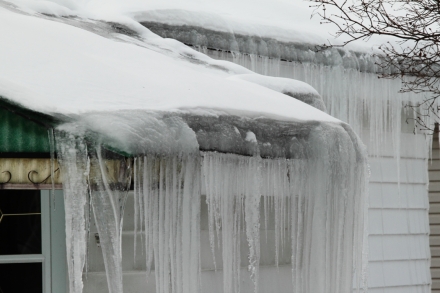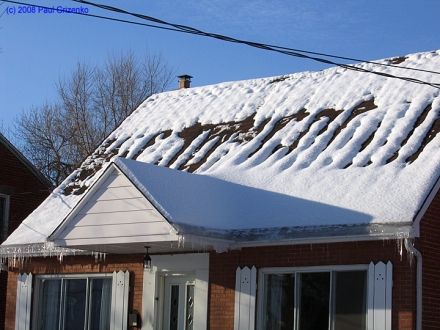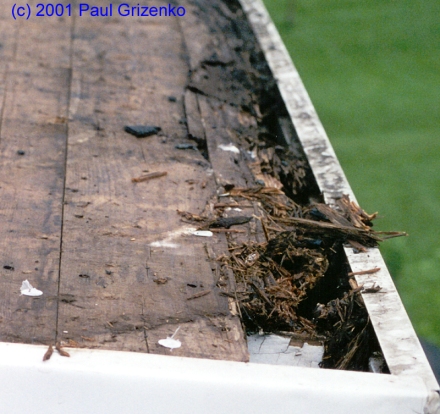An ice dam forms in winter on roofs where the snow melts on the warmer parts of the roof, runs down the slope to the eave, where it freezes.
As the freezing water accumulates, it forms an ice dam. The snow continues to melt, and eventually, the water starts backing up the slope of the roof. If there is no waterproofing membrane underneath the roof covering, then there is an excellent possibility that the water will find its way into the attic. From there, it may go down the walls (both inside and outside), or pool up on the vapour barrier and run down the slope to an opening.
Sometimes, there is no visible internal damage, at least not inside the house. That doesn’t mean that there is no problem. There is the chance that the leakage will cause the wood at the eaves to rot.
At other times, there is other type of damage, as in support for mold in the attic. If you have the following situation, the insulation should be removed, along with the decking, and the attic should be re-insulated, and the decking replaced.
Of course, the presence of the ice dam means that you’re losing heat to the outside. With the cost of energy these days, that just isn’t smart. So if you have pretty icicles forming along your roof edges, maybe it’s time to check if there is anything else going on. Just in case. If you’re not sure what you’re looking for, contact us.
(c) 2013 Paul Grizenko







I started noticing mold growing in some of the corners of my upstairs ceiling and wonder if it’s a problem with the roof. I didn’t realize that this was a possible concern and thought the mold was coming from inside the house. I will have to look more into finding a good roofing consultant to see what they think.
LikeLike
If you’re in Georgia, the conditions under which mold growth will occur will be rather different from what we expericnce in the Montreal, Quebec area. Your average ambient humidity levels are generally much higher than what we experience in our area. Therefore, some attention needs to be given to whether your issues with mold are condensation related, or leakage related. Condensation issues may be a factor of air conditioning levels and design, and will usually form at the transition between warm and cold. If the “warm” is outside, and the “cold” is inside, then condensation somewhere inside the wall or roof system. If it is a leakage issue, then it will start on the outside and find ways into the roof system.
LikeLike
Pingback: Ice Dams – a look at remediation | PRS Consulting